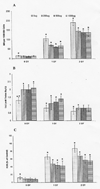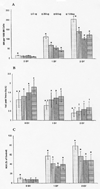American Ginseng Modifies Cs-Induced DNA Damage and Oxidative Stress in Human Lymphocytes
- PMID: 19946576
- PMCID: PMC2782928
- DOI: 10.2174/1876388X00901010001
American Ginseng Modifies Cs-Induced DNA Damage and Oxidative Stress in Human Lymphocytes
Abstract
The multifold bioactive medicinal properties of ginseng have been closely linked to its antioxidative ability, which is related to its ginsenoside content. Since the key mechanism of radiation-induced cell death and tissue damage is the generation of reactive oxygen species (ROS) that attack cellular DNA, this study focuses on the impact of a standardized North American ginseng extract (NAGE) on (137)Cs-induced oxidative stress in human peripheral lymphocytes (PBL) obtained from 10 healthy individuals (6M/4F), 42.7 +/- 4.6 years of age. At two different time points (0 h and 24 h before irradiation), we applied NAGE (250 - 1000 microg ml(-1)) to mononuclear cell cultures for cytokinesis-block micronuclei (MN) assay and determination of the state of oxidative stress in PBL. We found that at both time points, NAGE significantly reduced the MN yields in PBL after irradiation (1 and 2 Gy) in a concentration-dependent manner (P<0.001). Compared with radiation alone, the maximum reduction rate of MN yield were 51.1% and 49.1% after 1 Gy and 2 Gy exposures, respectively. We also found that before irradiation the presence of NAGE in the culture medium resulted in a significant increased intracellular total antioxidant capacity (TAC) in PBL. At both time points, the increment of (137)Cs-induced MN yields in PBL was positively correlated with the increment of intracellular ROS production (R = 0.6 - 0.7, P = 0.002), but negatively correlated with the reduction of TAC levels (R = -0.4 -0.5, P = 0.02 - 0.004). However, the presence of NAGE in the culture medium significantly increased the TAC levels, while concomitantly decreasing both ROS production and MN yields in PBL (P<0.001). Our findings that NAGE is effective in protecting human PBL against radiation-induced oxidative stress should encourage further in vivo study of dietary supplementation with NAGE as an effective natural radiation countermeasure.
Figures




Similar articles
-
Radioprotective effect of American ginseng on human lymphocytes at 90 minutes postirradiation: a study of 40 cases.J Altern Complement Med. 2010 May;16(5):561-7. doi: 10.1089/acm.2009.0590. J Altern Complement Med. 2010. PMID: 20491513 Free PMC article. Clinical Trial.
-
Effect of North American ginseng on 137Cs-induced micronuclei in human lymphocytes: a comparison with WR-1065.Phytother Res. 2008 Dec;22(12):1614-22. doi: 10.1002/ptr.2533. Phytother Res. 2008. PMID: 18803249 Free PMC article.
-
Ginseng reduces the micronuclei yield in lymphocytes after irradiation.Mutat Res. 2004 Jan 10;557(1):75-84. doi: 10.1016/j.mrgentox.2003.10.002. Mutat Res. 2004. PMID: 14706520
-
Micronuclei in lymphocytes of prostate cancer patients undergoing radiation therapy.Mutat Res. 2000 Aug 21;469(1):63-70. doi: 10.1016/s1383-5718(00)00072-3. Mutat Res. 2000. PMID: 10946243
-
The in vivo or ex vivo origin of micronuclei measured in human biomonitoring studies.Mutagenesis. 2011 Jan;26(1):107-10. doi: 10.1093/mutage/geq061. Mutagenesis. 2011. PMID: 21164190 Review.
Cited by
-
American Ginseng (Panax quinquefolium L.) as a Source of Bioactive Phytochemicals with Pro-Health Properties.Nutrients. 2019 May 9;11(5):1041. doi: 10.3390/nu11051041. Nutrients. 2019. PMID: 31075951 Free PMC article. Review.
-
Radiolabeling of poly(lactic-co-glycolic acid) (PLGA) nanoparticles with biotinylated F-18 prosthetic groups and imaging of their delivery to the brain with positron emission tomography.Bioconjug Chem. 2014 Dec 17;25(12):2157-65. doi: 10.1021/bc500315j. Epub 2014 Dec 1. Bioconjug Chem. 2014. PMID: 25322194 Free PMC article.
-
Comparison of Serum Metabolite Changes of Radiated Mice Administered with Panax quinquefolium from Different Cultivation Regions Using UPLC-Q/TOF-MS Based Metabolomic Approach.Molecules. 2018 Apr 26;23(5):1014. doi: 10.3390/molecules23051014. Molecules. 2018. PMID: 29701672 Free PMC article.
-
Protective effect of ginseng against gamma-irradiation-induced oxidative stress and endothelial dysfunction in rats.EXCLI J. 2013 Aug 30;12:766-77. eCollection 2013. EXCLI J. 2013. PMID: 26622217 Free PMC article.
-
Quality evaluation of Panax quinquefolium from different cultivation regions based on their ginsenoside content and radioprotective effects on irradiated mice.Sci Rep. 2019 Jan 31;9(1):1079. doi: 10.1038/s41598-018-37959-9. Sci Rep. 2019. PMID: 30705366 Free PMC article.
References
-
- Moulder JE. Pharmacological intervention to prevent or ameliorate chronic radiation injuries. Sem Radiat Oncol. 2003;13:73–84. - PubMed
-
- Moulder JE. Report on an interagency workshop on the radiobiology of nuclear terrorism. Molecular and cellular biology of moderate dose (1 – 10 Sv) radiation and potential mechanisms of radiation protection (Bethesda, Maryland, December 17–18, 2001) Radiat Res. 2002;158:118–124. - PubMed
-
- Pellmar TC, Rockwell S. Radiological/Nuclear Threat Countermeasures Working Group. Priority list of research areas for radiological nuclear threat countermeasures. Radiat Res. 2005;163:115–123. - PubMed
-
- Stone HB, Moulder JE, Coleman CN, et al. Models for evaluating agents intended for the prophylaxis, mitigation and treatment of radiation injuries. Report of an NCI workshop, December 3–4, 2003. Radiat Res. 2004;162:711–728. - PubMed
-
- Arora R, Gupta D, Chawla R, et al. Radioprotection by plant products: present status and future prospects. Phytotherap Res. 2005;19:1–22. - PubMed
Grants and funding
LinkOut - more resources
Full Text Sources
